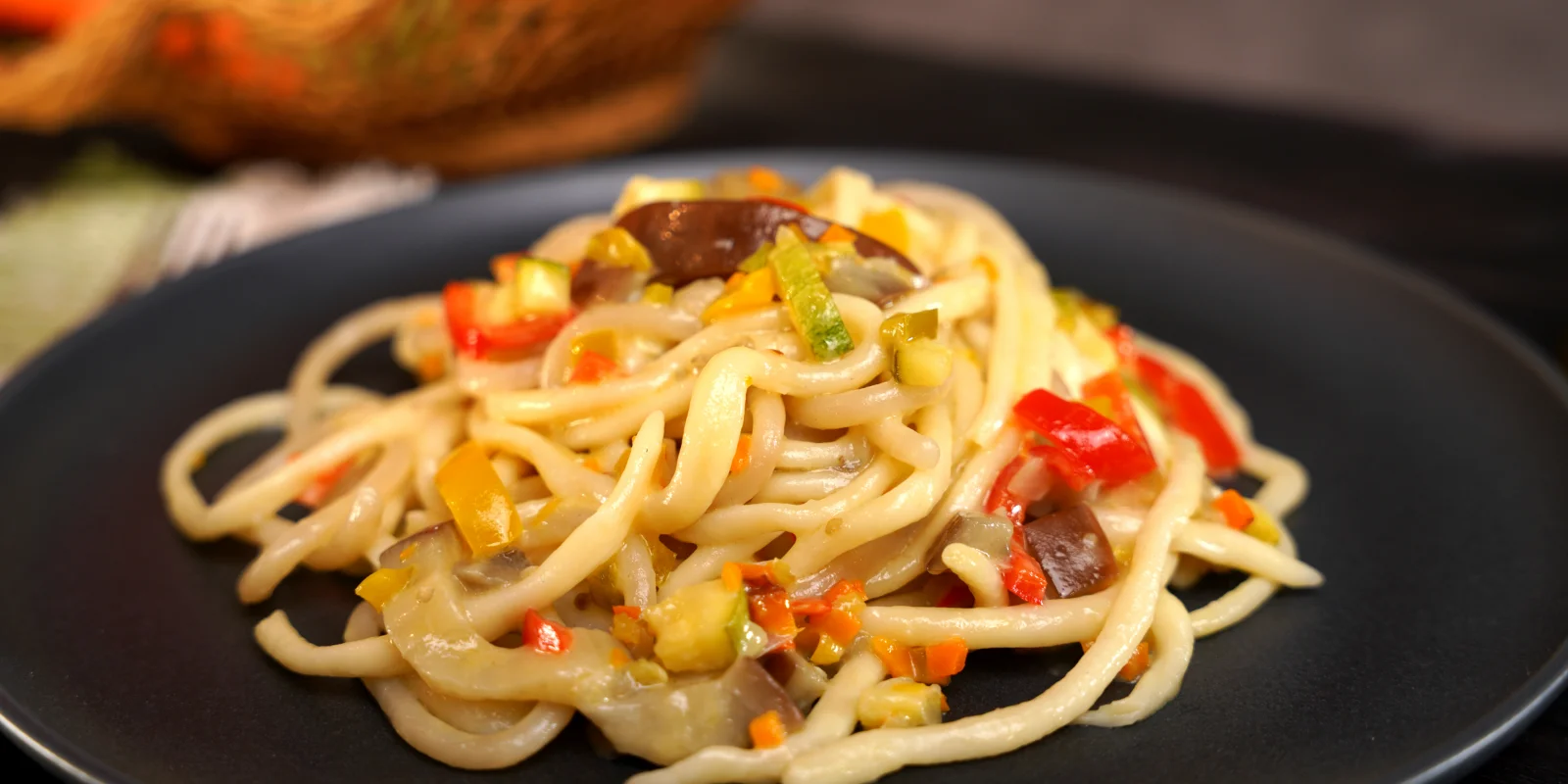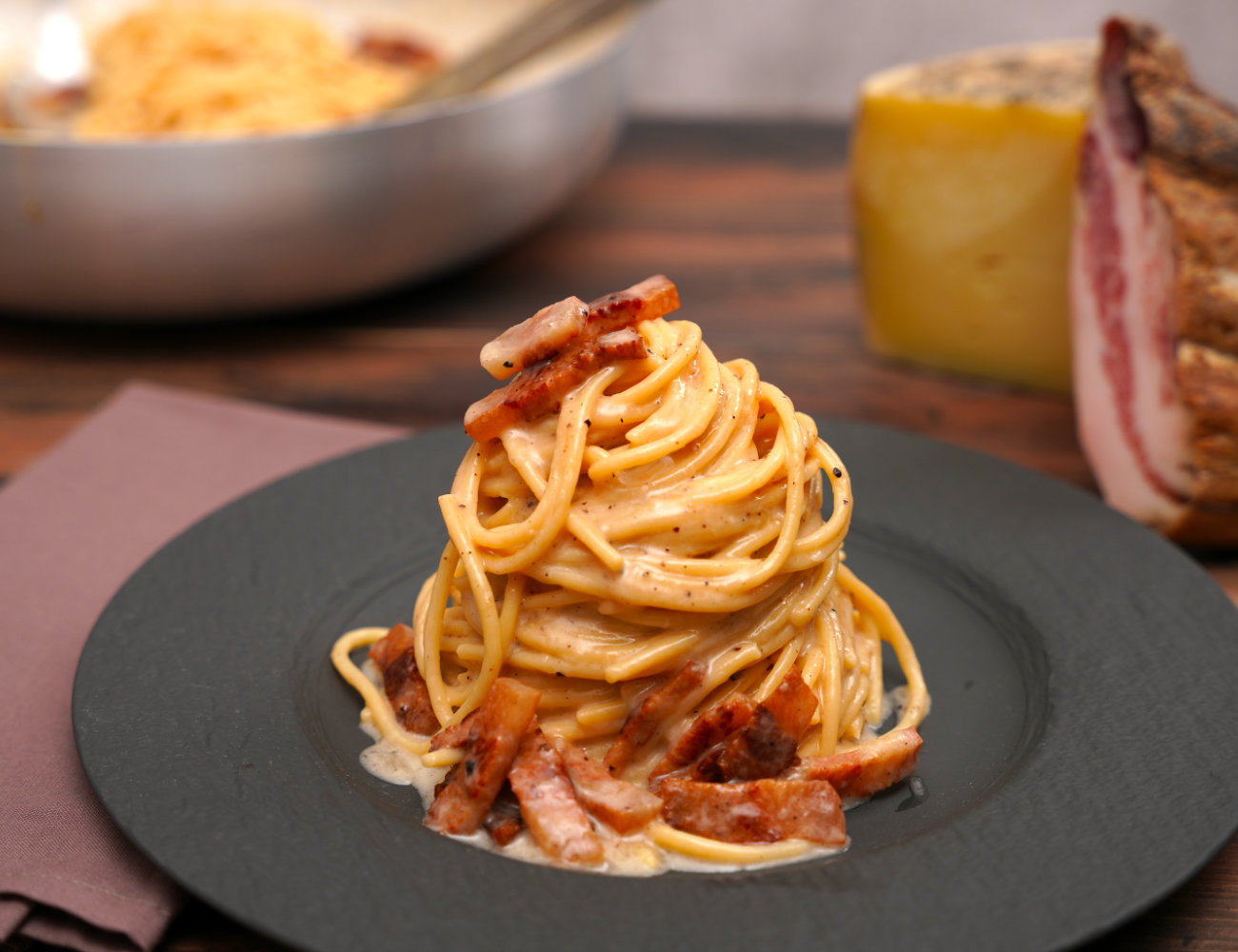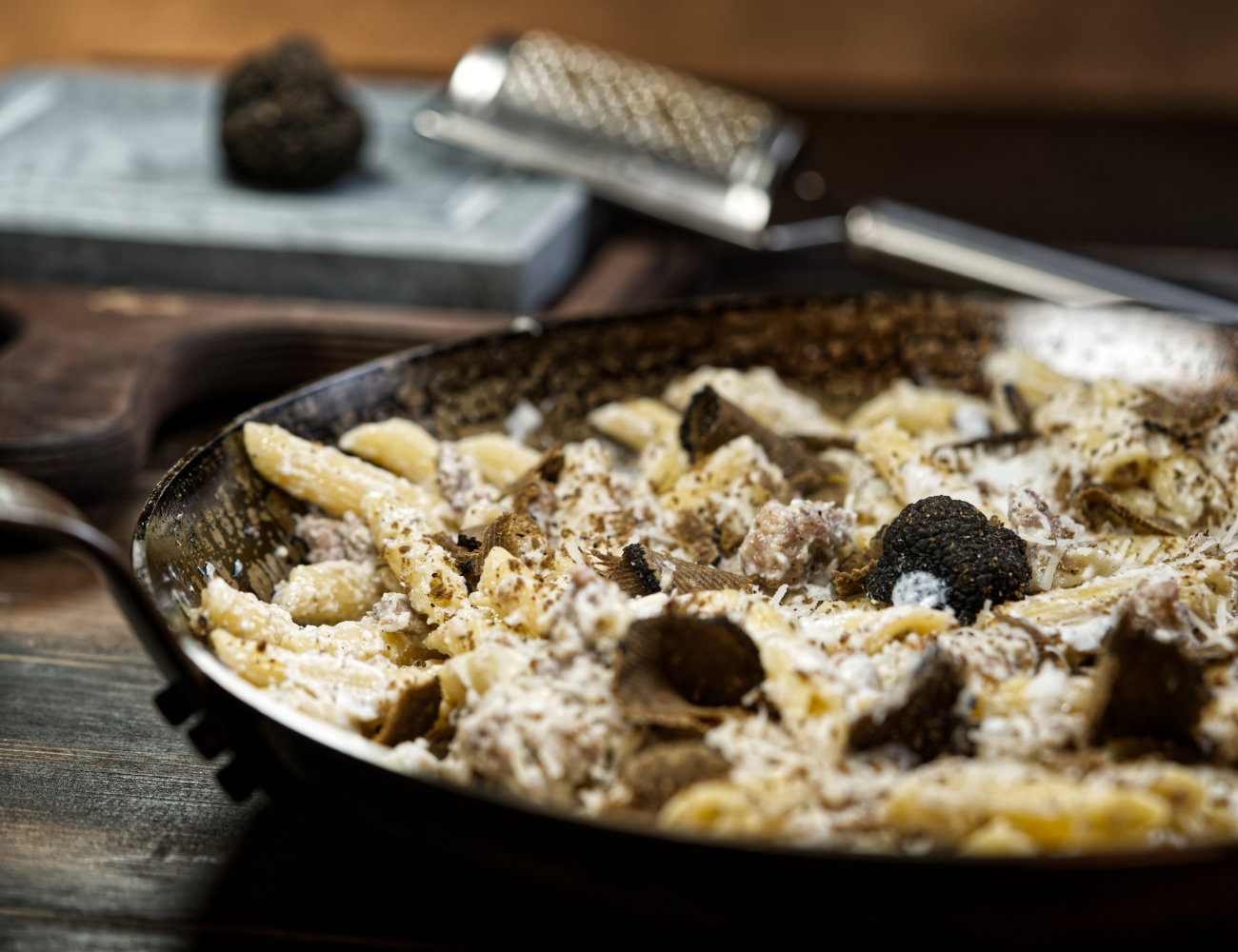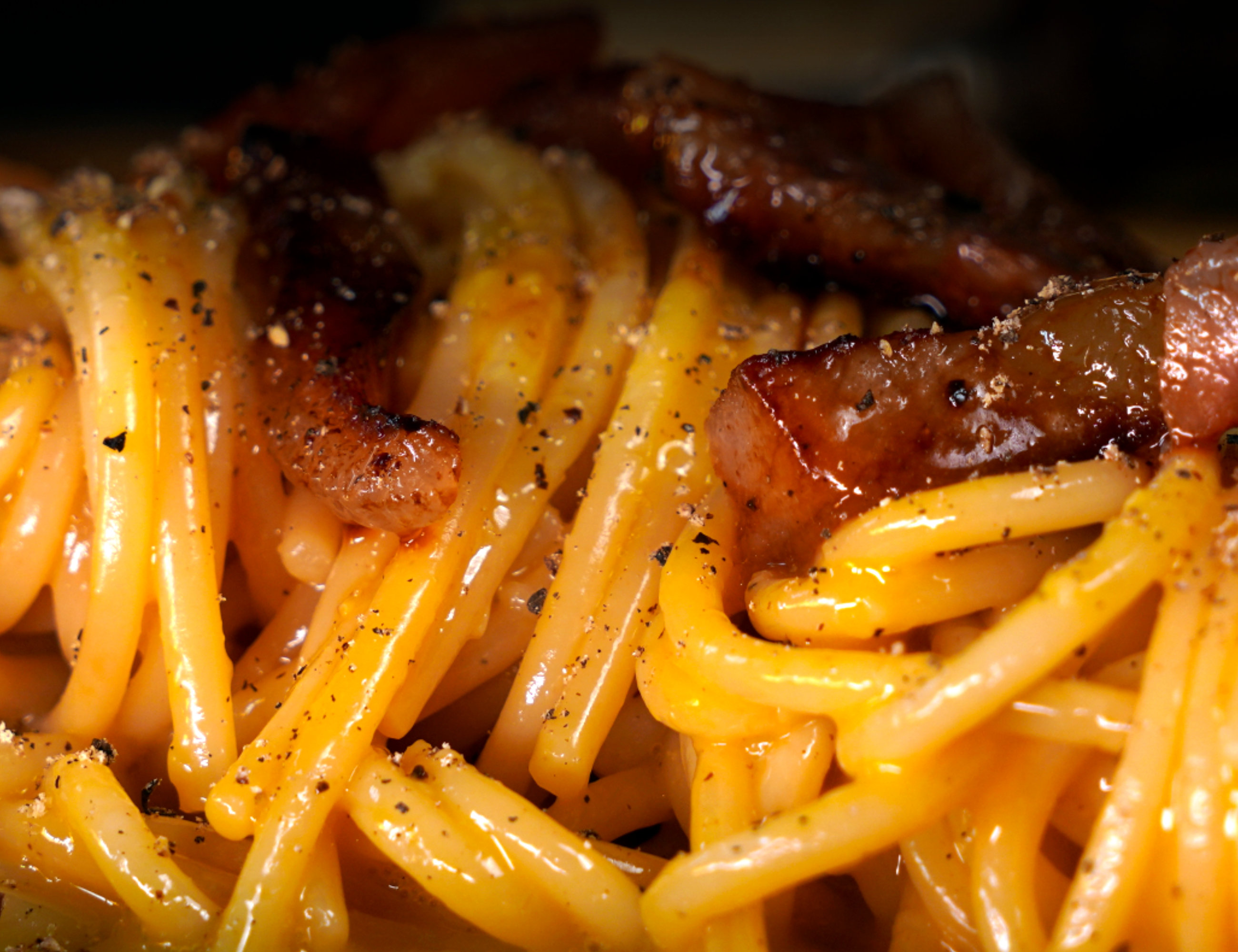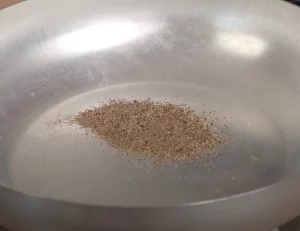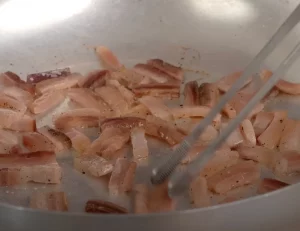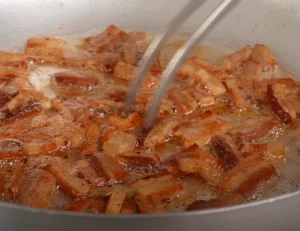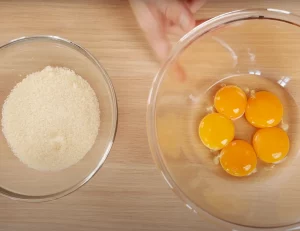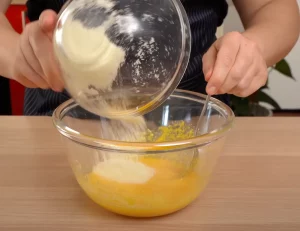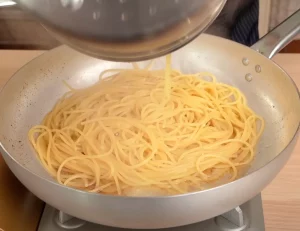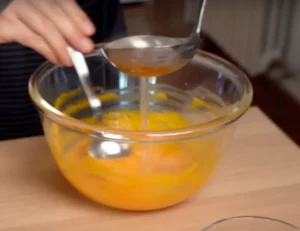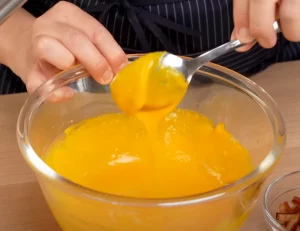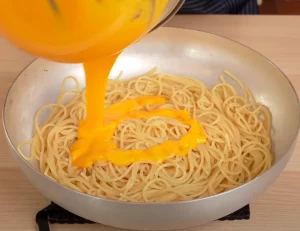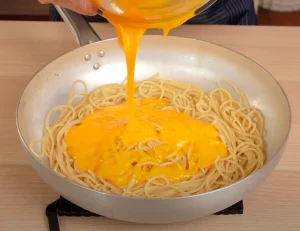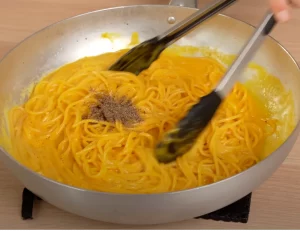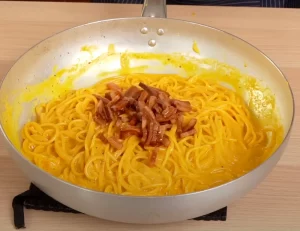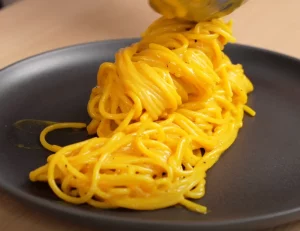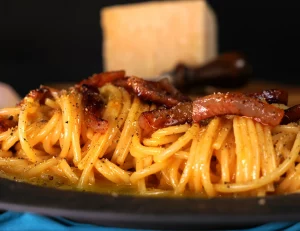The origins of the Spaghetti Carbonara is a matter of some controversy. Did the Americans or the Italians invent the Spaghetti Carbonara? Was this dish created in Rome as a way to use WWII ‘K-Rations’ ingredients?
In this post, we’ll investigate one popular theory of the origins of Spaghetti Carbonara: that of the ‘K-Ration.’
Prefer to start cooking? This is the Spaghetti Carbonara recipe considered traditional in Italy today!
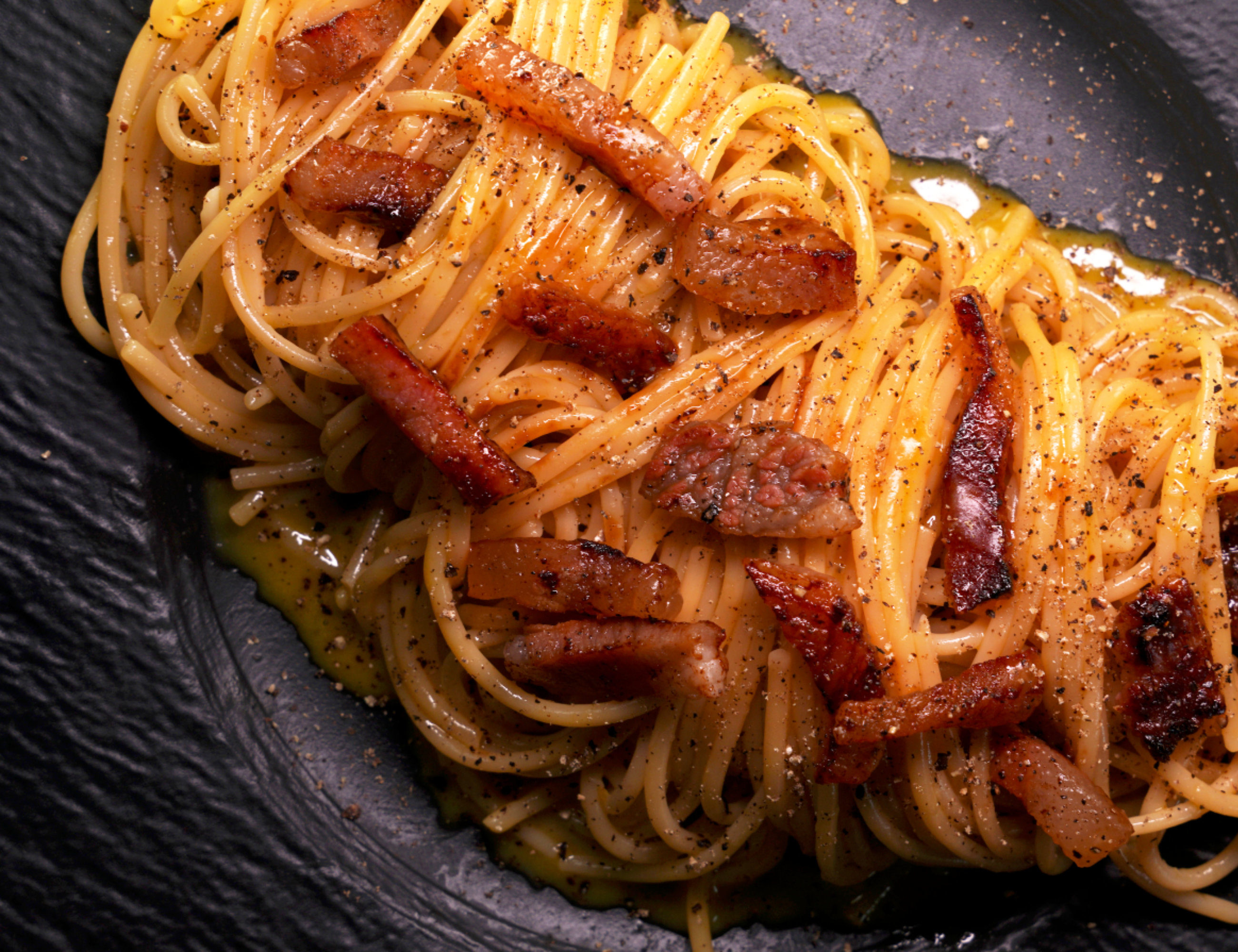
Watch the Video Recipe!
If you prefer to watch a video recipe, click on the video below.
Subscribe to our YouTube Channel
Birth of the Spaghetti Carbonara?
In this often repeated legend, the birth of the Spaghetti Carbonara began during WWII when American troops liberated Rome in 1944.
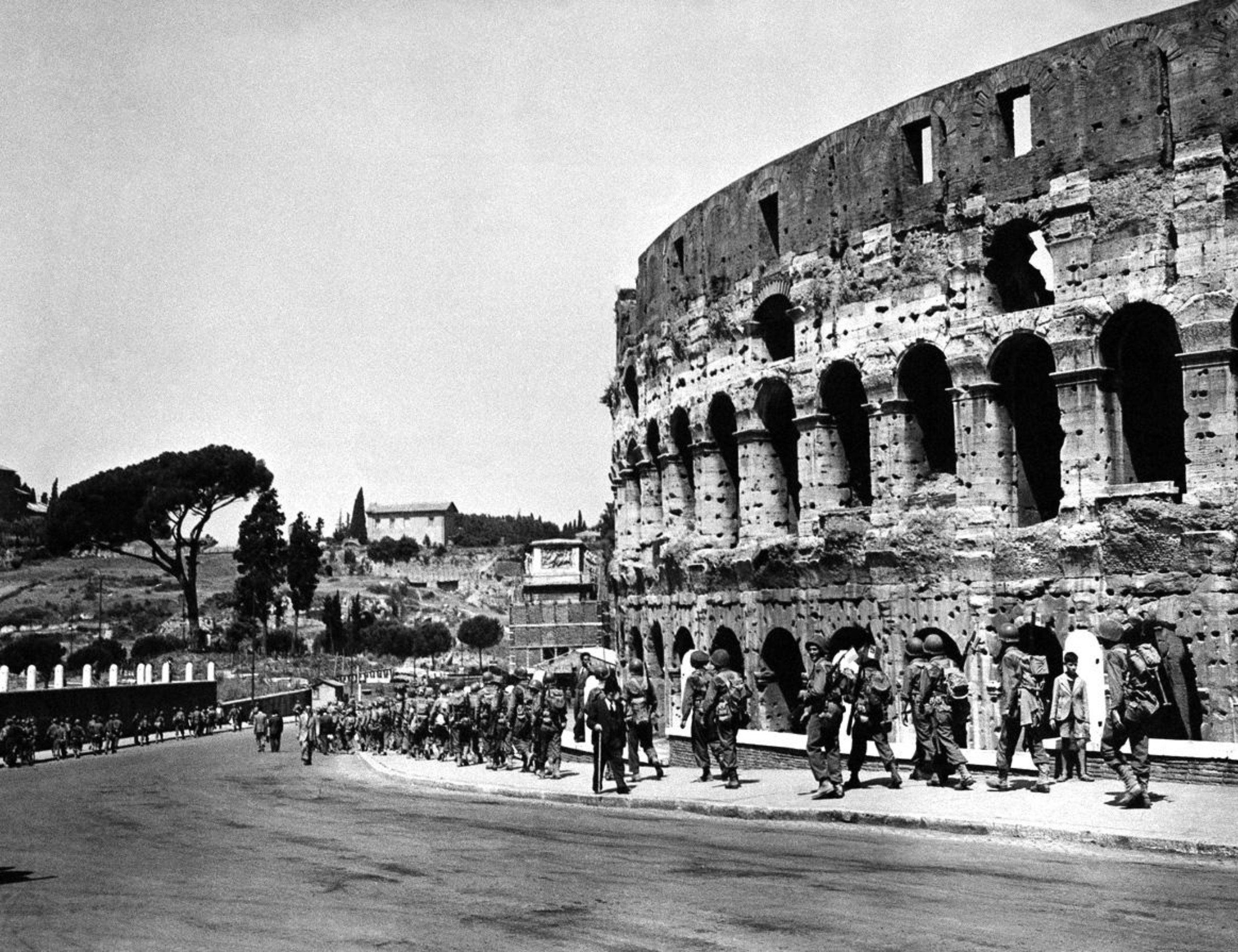
American troops were eager for a hot, substantial meal to liberate them from the boredom of their daily meal rations- specifically K rations. They took inspiration from local Rome chefs and combined forces to create the Pasta Carbonara—combining some eggs and bacon with Italian pasta and cheese.
This legend was recently reinforced by Barilla’s expensive looking dramatization, where an Italian chef has an ‘aha!’ moment when he watches as a truck with crates of K-Rations arrive at the WWII camp, and then removes slices of bacon from a can that seems to have come from the the K crates.
What Were K-Rations?
What were these infamous K Rations that the American troops were dying to get rid of? Rations were simply daily meals for the troops. There were many varieties for American Troops during WWII but K Rations were the most practical, yet most detested.
They were pre-prepared, packaged meals that required no cooking or refrigeration. They were originally designed for troops on the move who couldn’t reliably cook or prepare anything.
So what was in a K Ration that contributed to the birth of the carbonara? We don’t have to guess! Fortunately, the contents of those infamous K-Rations are very well documented.
K-Rations came in breakfast, lunch and dinner units. They looked like this:
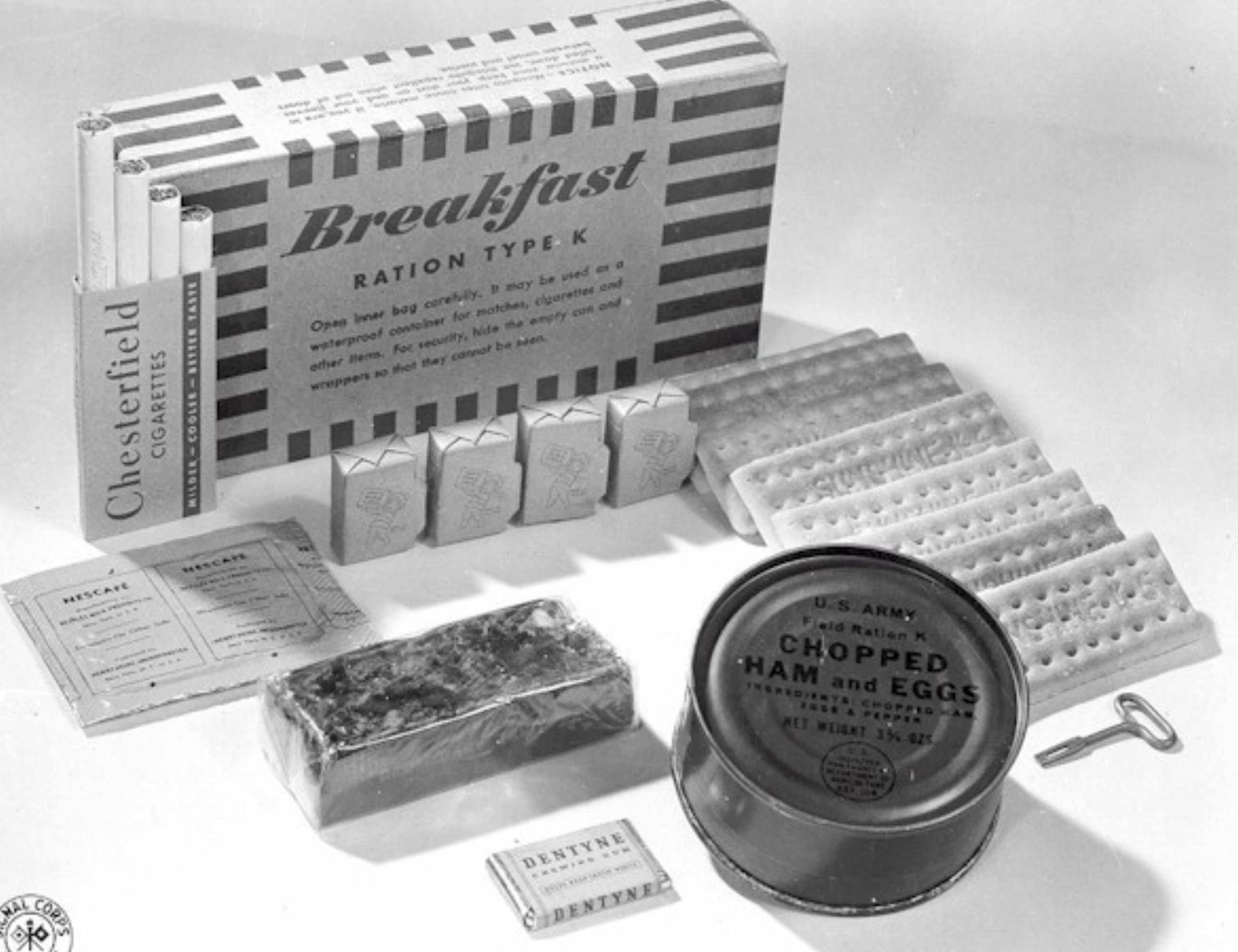
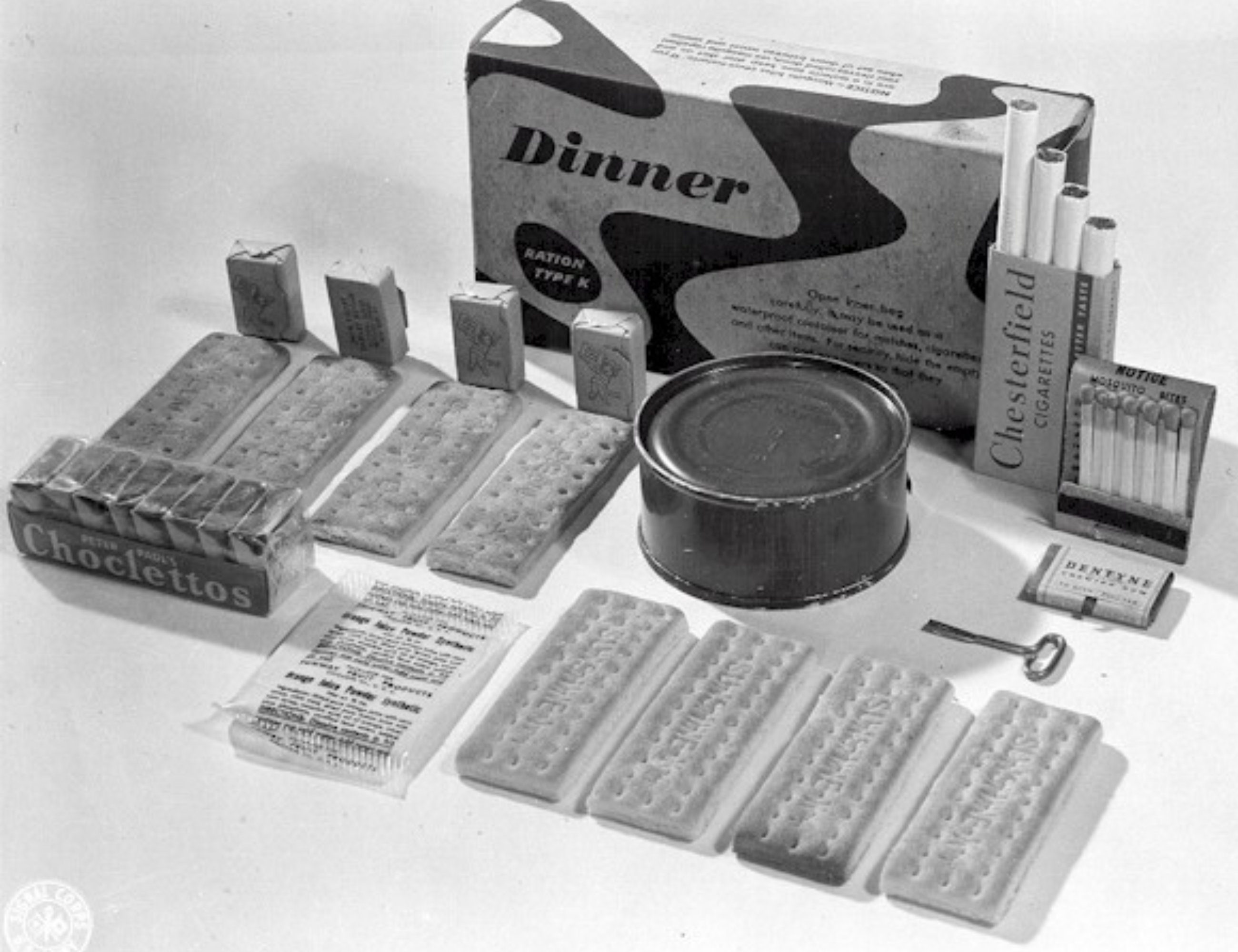
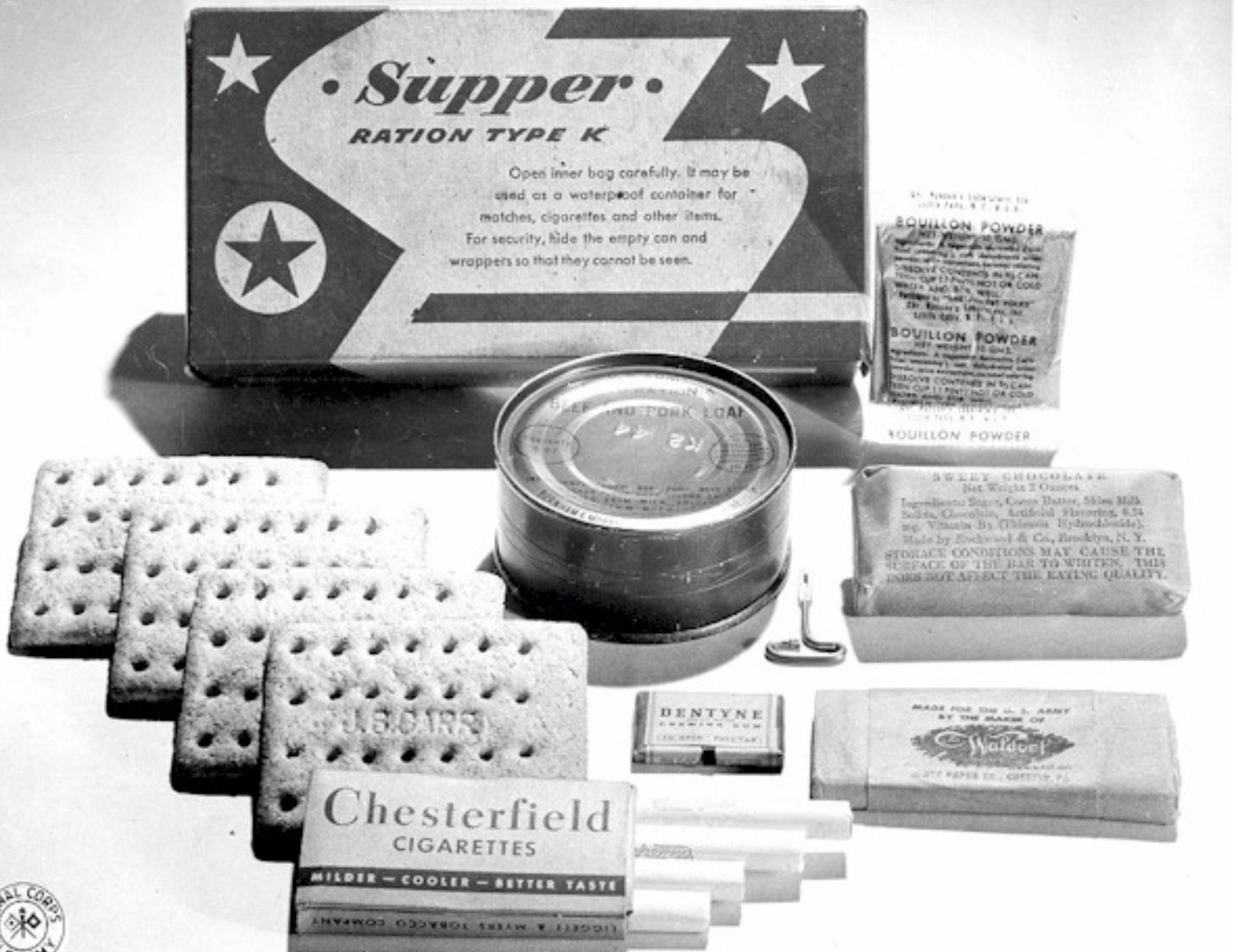
You can literally see a guy open up a K-Ration in this video !
There were a few versions of K Rations over time, and they had a bunch of different stuff in them to nourish and comfort troops. They included stuff like biscuits, fruit bars, chewing gum —even cigarettes and instant coffee!
However, for our purposes, we just care about the ENTREES that came pre-prepared in a can and could have been potentially used as ingredients for Spaghetti Carbonara. That means stuff with eggs, cheese, ham or bacon!
If the infamous K-Rations were indeed used as ingredients in the original Carbonara, then it must have had one of these ingredients:
- Canned Chopped Ham and Eggs – That means cooked ham and eggs, chopped.
- Canned Processed Cheese with or without Bacon – This seems to have been like Velveeta cheese with some bacon. Later versions had no bacon. So, like a spread and the bacon came with the cheese, it wasn’t separate.
- Canned Pork Luncheon Meat – Think Spam! You could have theoretically sliced it and tossed it in a pan… but this is far from ham or bacon.
That’s it! According to our extensive research, these are the only Carbonara-related ingredients that could have been in the K Rations!
K-Rations did NOT contain powdered eggs or slices of bacon—despite the myth that persists. Why? Remember that K-Rations were designed as pre-prepared, pre-packaged emergency meals. The powdered eggs or slices of bacon referenced in the Barilla film for instance must have come from other types of rations.
K-Ration Carbonara
So… Let’s assume for a moment that the legend of the K-Ration Carbonara is correct. What might it have looked like?
Well, it would have been a pretty strange dish by modern Carbonara standards. If the eggs came from the K-Ration, it would have been already cooked and chopped eggs with ham… tossed with some pasta.
If the ‘bacon’ came from the K-Ration as well, it would have been mixed with processed American or Swiss cheese. This would have created a creamy sauce, into which Pecorino or another local Italian cheese could have been added. However, it must have included a processed cheese. If we assume this was the only K-Ration ingredient used, we could have pulled in some powdered egg from the B-Ration to create an egg/cheese sauce—a bit more like a traditional Carbonara.
Otherwise, we’d be looking at something akin to scrambled eggs tossed with spaghetti and with a processed cheese sauce with some chunks of bacon. It could have been very comforting to American troops, but would not have in any way resembled the traditional Carbonara!
K-Ration Origin: Myth?
We are left wondering how K Ration ingredients came to be implicated in the birth of the Carbonara. However, it could have been simply the most visible ‘rations’ that Italians in liberated Rome were aware of.
The K Rations were so disliked by American troops that they were often the first rations distributed to civilians in need. This was particularly the case as other (tastier and more substantial) rations came to replace the K Rations.
A Better Origin Theory for the Carbonara
We’re calling BS on the K Ration myth. However, other WWII rations available to American troops could very likely have been ingredients in the original Spaghetti Carbonara! For instance…
A-Rations + B-Rations + 5-in-1 Rations
It makes much more sense that the Army cooks for the American troops were getting cheese or fresh eggs locally (called A-Rations), or using the powdered eggs that were abundant staples in the camps (B-Rations). They could have also been using the pre-cooked slices of bacon from the so-called 5-in-1 Rations.
K-Rations were supposed to be used only as short term meals. When near a camp, military cooks tried to prepare hot meals for the troops using A-Rations (fresh or frozen ingredients found locally) or B-rations which were canned or preserved ingredients that didn’t require a freezer or refrigerator.
So, American troops did have access to powdered eggs (dehydrated eggs), which were so important to the nutrition of American troops that the the military made this video which talks about how the powdered eggs could be shipped abroad for a fraction of the cost and didn’t require refrigeration. Mess hall cooks would add water to the egg powder to prepare lots of hot meals like omelets or pancakes, and other kinds of food.
One could easily imagine then adding water and cheese to rehydrate the eggs into a creamy sauce.
What about Bacon? After 1942, 5-in-1 rations were increasingly popular. Here’s a photo of this kind of ration, which did indeed include pre-cooked bacon slices.
So, in summary: By looking to other rations for ingredients, we can find a much more convincing origin for Spaghetti Carbonara.
What do you think the original Spaghetti Carbonara was like? Let us know in the comments and share any research you find that might shed light on the history of this fascinating dish!
Discover More Cheesy Italian Food Recipes
As an Amazon Associate, we earn from qualifying purchases. This means at no extra cost to you, PIATTO may earn a small commission if you click the links and make a qualifying purchase.
Spaghetti Carbonara Recipe
Equipment
- Kitchen Thermometer
- Large Pot
- Salt and Pepper Grinder
- Large Skillet
- Tongs
Ingredients
- 11 oz spaghetti dry is fine
- 1 tbsp black pepper freshly ground at a medium coarse setting
- 3.5 oz pecorino romano cheese finely grated; use semi-hard if you can find it
- 6 ¾ cups water for cooking the pasta
- coarse salt to taste
- 4 egg yolks
- 1 whole eggs
- 5 oz guanciale or pancetta
Instructions
Prepare Ingredients
- Freshly grate the pecorino with the finest setting available. You may use a food processor to do this quickly. Set aside.3.5 oz pecorino romano cheese
- Freshly grind the black pepper using a medium-coarse setting. You can use a mortar and pestle if you prefer. Toast the pepper over very low heat just until you can smell it. Then, remove it from the heat and set aside.1 tbsp black pepper

Fry the Guanciale
- Cut the guanciale into strips (about 1 inch x 1/3 of an inch). Fry the strips of guanciale in an uncreased pan over low heat.5 oz guanciale

- When the fat on the guanciale begins to turn transparent, increase the heat to medium. Continue frying the guanciale until it is golden brown and crispy. Set aside. Leave the guanciale grease in the pan. We will finish the dish in this pan.

Make the Sauce
- Combine one whole egg with 4 egg yolks and the pecorino cheese.4 egg yolks, 1 whole eggs

- Whisk the ingredients until smooth and creamy. Set the bowl aside.

Cook the Pasta
- In a medium-large pot, bring 6 ¾ cups of water to boil.6 ¾ cups water
- Cook the spaghetti about 3/4 of the time listed on the package instructions. Cook the spaghetti in a little less water than you normally would—this will create a pasta water with more starch. We want to use the starchy pasta water to finish the spaghetti in the skillet.Halfway through the cook time, add a handful of coarse salt to the pasta water.11 oz spaghetti, coarse salt
- Drain the pasta and immediately transfer it to the pan with the guanciale grease. Add a ladle of the pasta water to the pan along with the spaghetti. Toss the spaghetti with the grease and the pasta water.

- Add half a ladle of the hot pasta water to the egg and pecorino, whisking continuously as you add it.

- The result will be a creamier, shiny sauce.

Finish the Pasta
- Off the heat, immediately add the egg sauce to the still-hot spaghetti in the pan.

- Stir continuously with tongs to combine the carbonara sauce with the spaghetti. The still hot spaghetti will continue cooking and will cook the egg sauce a bit as well, melting the pecorino.

- Add the toasted black pepper…

- … and the fried guanciale. Continue mixing. The sauce will thicken as you stir.

- When the sauce is no longer runny, immediately plate and serve!

- Buon appetito!

Video
Notes
Nutrition

